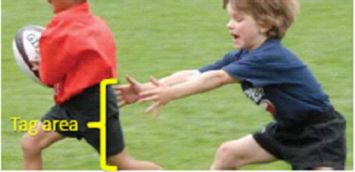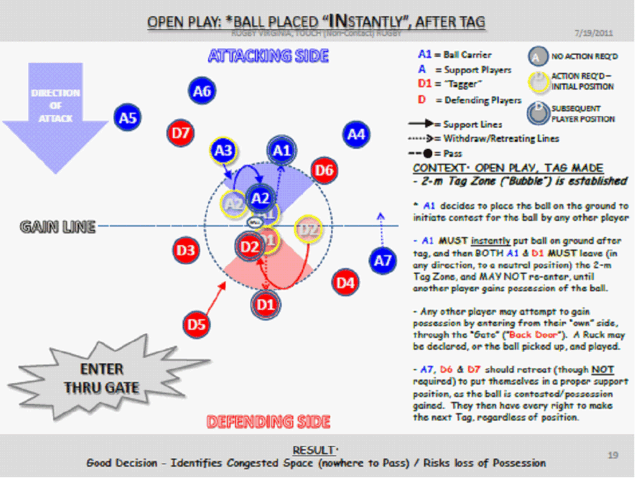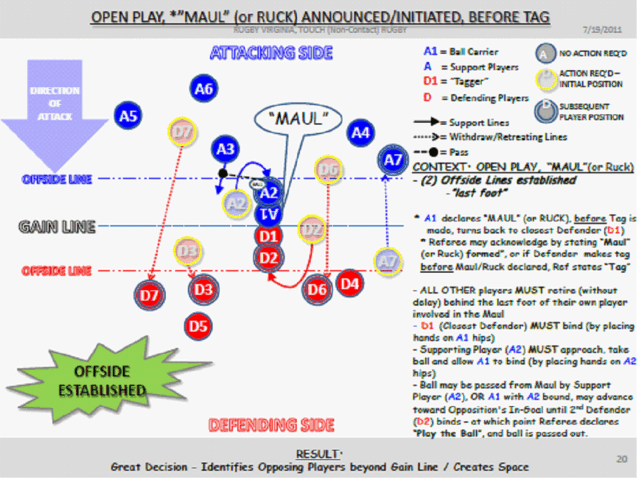


Rugby VA FULL TAG Law Clarifications, Questions and Answers
In Rugby Virginia we play COED Touch (Non-Contact) Rugby for Age Groups: U7 (PreK-K), U9 (Grades 1 & 2), U11 (Grades 3 & 4), and Tackle (boys and girls separate) for U13 (Grades 5 & 6), U15 (Grades 7 & 8) and High School (9-12).
Players and match officials must endeavor to ensure the World Rugby Laws of the Game, modified by the Rugby VA Mods, are observed when playing Touch (Non-contact) Rugby. The following Rules of Play for Rugby Virginia, Touch (Non-Contact) Rugby were derived from existing World Rugby Laws and are consistent with the spirit of the Game as defined under the Law and established regulation. These Rules of Play are intended to expound upon, better define, or state exception(s) specific to the rules under which the Rugby Virginia (RUVA) Youth program is played, based upon recognized World Rugby Law and Under-19 variations that govern the Game.
Object:
The object of the game is to score tries (five points), conversions (two points). If posts are properly positioned in the playing area then drop goals and penalty kicks (three points) may also be scored. A penalty try will be awarded if a try would probably have been scored but for foul play by the defending team. For the younger age groups, where score is kept; we will simply record the number of tries scored by each team.
Teams:
The Touch game is normally played between teams having a maximum of seven players, three of whom will be forwards and form the scrum, with the remaining players forming the back line. Each team can have an agreed number of substitutes. Substituted players can be re-used at the beginning of each period or to replace an injured player if no other replacements are available. Substitutions may only take place when the ball is dead or at the break between periods and always with the referee’s knowledge.
Notes:
Some variations of the “Touch” game might be played without the elements that are discussed below. This might be due to: age of the kids, wheterh or not they have practiced these elements, etc. For example on U-9 team, at the beginning of the season, might arrive to a match without having the opportunity to work on scrums and lineouts. The coaches will discuss, and it will be decided not to play using scrums during the match.
Schedule for the introduction of skills to fully benefit from the rugby experience:
1) Players must be able to perform restarts: that is: drop kicks for kick-off and restarts. No kicking tees are allowed.
2) Penalty kicks: understand the laws relating to penalties; and avoiding same. Players also need to know how to play penalty kicks awarded to them.
3) Players need to be capable of performing: Scrums
4) Players need to be capable of performing: Line-outs
5) Players need to be capable of performing: Mauls
6) Players need to be capable of performing: "22" drop-out
7) Players need to be capable of performing: Rucks
8) All skills/formations/variations
Starts / Re-starts:
- 1. the kick-off being taken again; or
- 2. the throw-in to a scrum at the center of the half-way line; or
- 3. accepting the kick and contesting a line-out at the half-way line.
- 1. the kick-off being taken again; or
- 2. their throw-in to a scrum at the center of the half-way line.
- 1. the kick-off being taken again; or
- 2. their throw-in to a scrum at the center of the half-way line.
- 1. off-side; or
- 2. twisting, grabbing, pushing or pulling the ball-carrier while in the act of tagging or during a ruck or maul; or
- 3. forcing or attempting to force the ball from the ball-carrier’s hands; or
- 4. pulling, pushing or obstructing an opponent who is not carrying the ball; or
- 5. attempting a tag by diving or leaving the feet; or
- 6. voluntarily causing a collision with an opponent, or
- 7. handing-off/fending-off ; (A hand-off being the placing of an open palmed hand by the ball carrier against an opponent’s face or body, while a fend-off is an outstretched arm by the ball carrier towards an opponent to discourage that person making a tag. Players should be encouraged to carry the ball in two hands to reduce the temptation to hand-off/fend off with a free hand.)
(a) A drop-kick from the center of the half-way line is used to start the game, the second half, and for all restarts after a score. The kicker’s team must be behind the ball and the receiving team must be at least ten meters away from mid-field line until ball has been kicked. Should a team not have a player who can successfully execute a drop-kick, then a player from the kicker’s team may hold the ball to allow for a place kick from the ground. No kicking tees are to be used for restart kicks.
(b) After a score the team that scored kicks off
(c) If, from the kick-off, the ball is kicked directly into touch, the opposition has the choice of:
(d) If from the kick-off the ball is not kicked ten meters, and the ball is not first touched by an opponent of the kicker, the opposition has the choice of:
(e) If from the kick-off the ball is is kicked into in-goal, without having touched or been touched by a player; the ball goes directly into in-goal and is then immediately touched down, or made dead; or, the ball goes into touch-in-goal, the opposition has the choice of:
(f) Following any on-field infringement for:
Sanction: >> after any of the above infringements, the match restarts at the place of infringement with a penalty kick to the non-offending team.
(g) After any stoppage not covered elsewhere in this Section, the match restarts with a scrum to the team moving forward or, if neither team was moving forward, to the team last in possession of the ball.
General Play
- 1. get up with the ball; or
- 2. pass the ball to another player; or
- 3. release the ball for another player to pick up.
(a) In general play, the ball can only be passed sideways or backwards, defined as “towards the player’s own dead-ball line”. If the ball is thrown forward or knocked on, a scrum is awarded to the opponents unless the referee plays advantage to the non-offending team.
(b) Off-side in general play is penalized in accordance with the IRB Laws of the Game. A player off-side in general play is to be penalized for being off-side unless that player is making an obvious attempt to return to an on-side position. Sanction: Penalty kick.
(c) If a player carrying the ball goes to ground in general play or if a player goes to ground to gather the ball in general play, the player must immediately do one of three things, or be penalized:
Sanction: Penalty kick.
(d) If the player on the ground with the ball is touched with both hands on the torso or legs by an opponent who is not on the ground, then the player on the ground now may no longer get up with the ball, but must either pass or release it.
Sanction: Penalty kick.(e) It is illegal for any player to voluntarily fall on or over a player lying on the ground with the ball or to voluntarily fall on or over players lying on the ground with the ball between them, or near them.
Sanction: Penalty kick.Note: No advantage shall be played. A player is assumed to have fallen voluntarily unless the referee is absolutely certain the fall was accidental. In the very rare instances when the fall is accidental, play must be stopped and a scrum awarded to the team previously in possession. The objective is to remove a dangerous area of play, keep players on their feet and prevent them from falling to the ground.
The TAG
(a) A tag occurs when an opponent simultaneously touches the ball-carrier with both hands anywhere from the waist to the knees, and the referee declares “Tag”.
(b) Players should have shirts tucked in to assist the Referee in identifying the Tag
(c) A tag can only take place in the playing area. If a ruck or maul has been declared first, then a tag cannot occur.
(d) Tags above the waist SHOULD NOT be allowed! If observed, Referee should instruct Ball Carrier “Play On –No Tag”
(e) Opponents must be on their feet to tag the ball-carrier. The ball-carrier shall not fall to the ground to avoid a tag.
Sanction: Penalty kick.(f) When the ball-carrier is tagged in the field of play, then the ball-carrier must play the ball immediately. To play the ball, the ball-carrier must pass the ball or release the ball. The ball-carrier may continue running while playing the ball, but the ball must be played within two steps or one second. Additional time may be allowed at U9 level.
Infraction: Scrum with opponents to throw in the ball.(g) After playing the ball because of a tag the tagged player may not intentionally touch the ball again until either the ball has been made dead, touched intentionally by an opponent or touched intentionally by at least two team-mates.
Sanction: Penalty kick.(h) The tagger must not interfere with play, and must move two meters away from the ball-carrier and assume a neutral position while raising both hands near, or above the shoulders. Furthermore, the tagger may not move towards an opposition support player to whom the ball-carrier could pass the ball. However, as soon as the ball leaves the hands of the ball-carrier the tagger may leave the neutral position.
Sanction: Penalty kick.(i) After a tag, the opponents (taggers’ team) must allow the ball-carrier to play the ball. The opponents may not be any closer than two meters from the ball-carrier. No part of an opponent’s arms or legs may be extended within the two meter zone.
Sanction: Penalty kick.(j) Opponents other than the tagger may position themselves between the ball-carrier and other members of the ball-carrier’s team. These players may intercept the ball after it has been played.
(k) Upon being tagged, the ball-carrier may place the ball on the ground instantly. Instantly is different from immediately. Playing the ball immediately means at or before the “ly” at the end of pronouncing the word im-med-i-ate-ly. Placing the ball instantly means at the “in” at the beginning of pronouncing the word instantly, without taking further forward steps. When this is done, a tag zone is created. This is a circle with a two meter radius with the center being where the ball is placed.
(l) Once this zone is created any of the players, other than the ball-carrier and tagger, may enter it from the direction of their own goal line, and play the ball. Think of the zone as a house with the front door facing the opponents’ goal line. Players must enter through the back door. Players may not use the side or the front doors.
Sanction: Penalty kick.(m) While the ball is in the zone the tagger of the original ball-carrier and the original ball-carrier must both take neutral positions. They may not re-enter the tag zone until players other than themselves have taken possession of the ball or the ball has left the tag zone.
Sanction: Penalty kick.(n) Any player, including the tagger and ball-carrier, may be located anywhere outside the zone. There are no off-side lines established.
(o) If the ball-carrier is in the field-of-play and is approaching the goal line and starting to reach out to touch the ball down in in-goal as the tag occurs, then the ball carrier should be allowed to complete the movement and, if successful, be awarded a try or a touch down accordingly.
Further notes and clarification on the TAG:
- a. There is NO off-sides at the tag (tackle)
- b. However, players must react similarly as they would in the Tackle game. I.E.: Tagger should raise his hands (equates to releasing the Ball Carrier if involved in the Tackle (Tag), retreat away, and allow the tagged Ball Carrier the opportunity to play the ball.
- c. This allows opposition to take advantage of sloppy offload pass by attacking team
- d. This demands that ball-carrier’s teammates position themselves to support ball-carrier and ensure possession of the ball
- a. Placing the ball on the ground to establish the 2-m tag zone and “gate” (as in the tackle game)
- b. Employment of the Ruck & Maul, which establish the Off-sides line
(a) See picture to the right of where the TAG must occur

(b) Within the context of emulating the Tackle game:
(c) This Law further promotes methods/techniques that are consistent with the Tackle Game
(d) See the 2 diagrams below showing the sequence of events that occur during a TAG
(I.) SEE THE OPEN-PLAY “BALL PASSED IMMEDIATLY” DIAGRAM FOR FURTHER UNDERSTANDING
(II.) SEE THE OPEN-PLAY “BALL PLACED" DIAGRAM FOR FURTHER UNDERSTANDING

Maul:
(a) A maul can only take place in the field-of-play. There shall be no contest for the ball during any part of a maul.
(b) When a ball-carrier who has not been tagged comes near to an opponent and then turns away from the opponent’s goal line and declares “Maul”, then a tag cannot take place, and the ball-carrier must set a maul. If the ball-carrier has turned but is tagged before declaring the maul, the referee declares “Tag” and thereby disallows the maul. As soon as a maul is declared any player may take part in that maul, including players of either team that, prior to the maul being declared, were taking neutral positions as a result of a previous tag.
(c) The nearby opponent, without interfering with the play of the ball, must immediately approach a position behind the ball-carrier and shall properly bind by holding the ball-carrier at the hips with both hands. The ball-carrier must offer, but not throw, the ball to a supporting teammate.
Infraction: Scrum with the opponents to throw in the ball.(d) All other players of both teams must retire, without delay, behind a line drawn parallel to the goal lines through the hind most foot of those players teammates’ who are taking part in the maul. Otherwise those players are off-side and liable to penalty.
Sanction: Penalty kick.(e) A supporting player of the ball-carrier’s team must immediately approach from behind the hindmost foot of the ball-carrier close enough to take the ball, and shall then turn away from the opponents’ goal line, allowing the first ball-carrier to properly bind by holding the supporting player at the hips with both hands.
Infraction: Scrum with the opponents to throw in the ball.(f) A second opponent, without interfering with the play of the ball, may join the maul from behind the hindmost foot of the first opponent, and must properly bind by holding the first opponent at the hips with both hands.
Infraction: Scrum with the opponents to throw in the ball.(g) The ball may not be released from the maul before a supporting team-mate has taken the ball and has become properly bound by the player that declared the maul. As soon as the supporter becomes properly bound the ball may be released from the maul either by the supporter handing the ball to a team-mate or by the supporter throwing the ball backwards from the maul.
Infraction: Scrum with the opponents to throw in the ball.(h) As soon as the four players that may form a maul are in position and properly bound the referee declares “Play the ball” and the supporting player must immediately hand the ball to a team mate or throw the ball backwards from the maul, in which event any on-side player of either team may approach and play the ball.
Infraction: Scrum with the opponents to throw in the ball.(i) If two players from the ball-carrier’s team become properly tagged up significantly before the second opponent becomes tagged up then the referee declares “Advance” and the ball-carrier’s team may, while still facing their own goal line, advance at a walking pace towards their opponents’ goal line. The opponent must not resist that advance. As soon as the second opponent becomes properly bound up the referee declares “Play the ball”.
(j) If two players from the opponents’ team become properly bound significantly before the supporting player of the ball-carrier’s team becomes tagged up then the referee declares “Turnover”, and awards a scrum with the opponents to throw in the ball.
(k) If the second players from each team approach and become properly bound at substantially the same time then the referee declares “Play the ball”, regardless of which second player is the first to bind.
Rucks:
(a) A ruck can only take place in the field-of-play. There shall be no contest for the ball during any part of a ruck. At least one player from each team must be in close proximity to the ball for a ruck to be declared.
(b) A ruck may be declared in two circumstances. First, a ball carrier may, before being tagged, place the ball on the ground, crouch over it and declare “Ruck”. Second, when the ball is otherwise on the ground any player may crouch over the ball and declare “Ruck”. In either event a tag cannot take place and the player must set the ruck. If the player has crouched but is tagged before declaring the ruck, the referee declares “Tag” and thereby disallows the ruck.
(c) Collisions must be avoided. Priority shall be given to the first player that attempts to crouch over the ball. Only players on their feet may declare a ruck. A player that crouches over the ball and does not declare a ruck, but prevents an opponent from playing the ball is guilty of obstruction.
Sanction: Penalty Kick.(d) If the ball is on the ground because a ball carrier placed it there instantly after the tag, then players approaching the ball with intentions of declaring a ruck must do so from their side of the established tag zone. They must come through the back door.
Sanction: Penalty kick.(e) The player that declares the ruck becomes the "setter". After a ruck is declared, the opponent closest to the setter must immediately approach a position in front of and facing the setter, and also take a crouched position. The setter and opponent shall then bind onto each other by placing a hand on each other's shoulder.
Infraction: Scrum with opponents to throw in the ball.(f) All other players of both teams must retire, without delay, behind a line drawn parallel to the goal lines through the hind most foot of those players’ team-mates who are taking part in the ruck. Otherwise the players are off-side and liable to penalty.
Sanction: Penalty kick.(g) Once the setter and opponent have bound onto each other the ball may be released from the ruck either by another team-mate of the setter placing two hands on, or picking up, the ball or by the setter or team-mate heeling the ball backwards from the ruck, in which event any on-side player of either team that is not participating in the ruck may approach and play the ball.
(h) Until the ball is released, supporting players, one from each team, may approach from an on-side position and, without interfering with the ball, bind onto and alongside their teammates that are already in the ruck by placing an arm around the team-mates’ torsos. The supporting players may bind on either side of their team-mates. All players who participate in the ruck must take a crouched position with knees bent.
Infraction: Scrum with opponents to throw in the ball.(i) While taking place the ruck must stay at the place that it was set, and must not move towards either goal line, or move sideways.
Sanction: Penalty kick.(j) The ball may not be released from the ruck before the setter’s team-mate has become properly bound. When the team-mate becomes bound the ball may be released from the ruck either by another team-mate of the setter placing two hands on, or picking up, the ball or by the setter or team-mate heeling the ball backwards from the ruck, in which event any on-side player of either team that is not participating in the ruck may approach and play the ball.
Infraction: Scrum with opponents to throw in the ball.(k) As soon as all of the players that may form a ruck are in position and properly bound the referee declares “Play the ball” and the ball must be released immediately from the ruck by the setter’s team.
Infraction: Scrum with opponents to throw in the ball.(l) If two players from the opponents’ team become properly bound significantly before the supporting player of the setter’s team becomes bound then the referee declares “Turnover”, and awards a scrum, with the opponents to throw in the ball.
(m) If the second players from each team approach and become properly bound at substantially the same time then the referee declares “Play the ball”, regardless of which second player is the first to bind.
(n) If the ball is on the ground because a ball carrier, upon being tagged, had instantly placed the ball, then neither that tagged ball carrier, nor the tagger may join the ruck or remove the ball from the ruck, nor may they be the first player to touch the ball if it is heeled from the ruck. Infraction: Scrum with opponents to throw in the ball.
Further notes and clarification on Rucks and Mauls:
- a. Because it sets Off-sides lines, thereby creating space for the attacking team
- b. Defending team players must retire to their side, behind last foot, to be considered on-sides
- c. Ensures that Rugby’s distinctive features are maintained – as the goal is for our kids to develop into Tackle rugby players later.
(a) Why do we employ Rucks and Mauls in Touch/Tag?

Scrums:
- 1. Follow the ball whilst remaining on side, or
- 2. Go directly back to the hindmost foot in the scrum and then take up a position anywhere in the Field of Play behind this offside line
(a) A scrum can only take place in the field-of-play. There is no contest for the ball at any part of a scrum.
(b) The scrum will be made up of one row of three players from each team, i.e. a prop on either side of the hooker.
(c) Before starting the engagement procedure the players from each row will bind together approximately half a meter from their opponents, with the props each binding firmly with one arm around their hooker, and the hooker with arms binding firmly around each prop. In all binds the hands will be at or below the level of the armpit. Each prop will then touch the upper arm of the opposing prop and pause before the engagement. The referee will talk the players through the engagement procedure in the sequence “Crouch, Touch, Pause and Engage”. On the grounds of safety, it is important that referees manage the engagement of every scrum in this way.
Sanction: Free pass.(d) The team awarded the scrum will throw the ball into the scrum and must be allowed to win it without contest. Opponents cannot push or strike for the ball.
Sanction: Penalty kick.(e) The back lines of both teams must remain five meters behind a line through the hindmost foot of their props/hooker until the ball emerges or the scrum-half places both hands on it.
Sanction: Penalty kick.(f) If a scrum is awarded within five meters of the goal line, the scrum is to be taken at a mark such that the middle line of the scrum is five meters from the goal line.
(g) The scrum-half not throwing the ball into the scrum may follow the ball as it moves in the scrum, but must not overstep a line through the ball while it remains in the scrum. If either scrum-half moves from a position close the scrum, then the scrum-half must retire behind the same offside line as that for the backs.
Sanction: Penalty kick.(h) After the ball has been won the scrum half of the team who has not won the ball who was positioned next to the player throwing in the ball can do one of two things:
(i) If the scrum-half throwing in the ball places two hands on the ball as it emerges the opponent may tag the scrum-half, but must not prevent the scrum-half from playing the ball, or attempt to swat the ball from their hands.
(j) In the interests of player safety, where a penalty or free pass is awarded for an infringement during a scrum, the kick may not be taken quickly and players must wait until the referee signals that the kick/pass may be taken.
Line-outs:
- 1. when the ball is thrown or knocked out of the line-out
- 2. when a line-out player hands the ball to a player who is peeling close to and parallel to the line / Note: “Peeling” occurs when a player leaves the line-out (after the ball has been thrown in) to catch the ball knocked or passed back by a team-mate, or to take the ball from a team-mate who has caught and held it. All “peeling off” movements must be close to and parallel with the line-out. Players must keep moving
- 3. when a maul develops in a line-out, and both feet of all the players in the maul move beyond the line-of-touch
- 4. when a ruck develops in a line out and the ruck ends; and
- 5. the ball has been passed or carried out of the line-out.
(a) If the ball or player carrying the ball goes out of play, a contested line-out will take place, except at the U9 level. U9 Line-outs will be uncontested. If a line-out is awarded within five meters of the goal line, the line-out is to be taken at a mark five meters out from the goal line. If the ball is kicked into touch from a penalty kick the throw-in is taken by the kicker’s team, otherwise the throw-in is taken by the opponents of the team that carried or last touched the ball before it went into touch.
(b) A quick throw-in is not permitted
(c) The line-out will be made up of two players from each team (who stand between 5 and 15 meters from the touch line) plus the player throwing the ball in and an immediate opponent (who must stand within two meters of the player throwing the ball in) and one player from each team in a position to receive the ball (i.e. scrum-half). The receiver may move into the lineout prior to the throw and perform any of the actions available to any other player in the lineout. Both the thrower and the immediate opponent are able to take an active role in the line-out as soon as the ball has been touched by one of the players in the line-out. Players not taking part in the line-out must stay behind the off-side line until the line-out ends.
(d) The off-side line for all players not participating in the line-out (all players other than those described in this Section) is ten meters back from the line-of-touch, parallel to the goal line, and the players must remain behind that off-side line until the line-out has ended. If the line-out is closer than ten meters to the goal line, the goal line is the off-side line.
Sanction: Penalty kick at the offside line.(e) The line-out begins when the ball leaves the hands of the player throwing it in. Players of either team may jump to contest for the ball except at U9 level (no contest), but there must be no further contest for the ball once possession has been clearly won. The line-out ends when the ball or a player carrying it leaves the line-out. This includes the following:
(f) Lifting/supporting except at U9 level (U9 no lifting) will be managed by the referee, based upon demonstrated skill/ability of those players participating in the lineout
Kicking:
(a) All the World Rugby Laws of the Game pertaining to kicking in open play apply
(b) After a player scores a try (or penalty try) the player's team has the right to attempt a conversion kick to score a goal, worth an additional two points. Ideally, a conversion kick should be taken as a place kick or drop kick from a place on a line drawn parallel to the touch lines through the point where the try was scored. It should be made at posts positioned at the center of the goal line. However, in youth Touch (non-contact) rugby such conditions are not always available, or even appropriate. Smaller than standard fields often preclude properly positioned posts, and very young players lack the physical characteristics to be able to kick the ball any great height or distance. The conditions for the conversion kicks should be set with the spirit of the ideal in mind, but in a manner that makes successful kicks challenging but possible.
(c) If posts are suitably placed within the playing area then players may try for a drop-goal in general/open play or for a goal by a place kick or a drop kick after a penalty has been awarded. If successful, each is worth three points
(d) If posts are located on the dead-ball line (rear of the try zone/In-goal area), than the attempt for a conversion may anywhere from the dead-ball line through point where the try was scored and perpendicular to the try-line. The defending team shall retire behind the dead-ball in order to charge/contest the conversion attempt, if the try-line is in front of the posts
(e) When an infringement occurs, a penalty or penalty kick will be awarded in accordance with the World Rugby Laws of the Game. The referee will make a mark for the kick. The opposition will retire quickly to ten meters from the mark. If the kick is taken so quickly that opponents have no opportunity to retire, they will not be penalized for this. However, they must continue to retire without interfering with the game until they are either ten meters from the mark or a team-mate who was standing ten meters from the mark has run in front of them. The opposing team must not do anything to delay the penalty kick or obstruct the kicker. Any infringement by the opposing team results in a second penalty ten meters in front of the mark for the first kick. On the second occasion the kick will not be taken until all opponents have retired ten meters. No penalty can be taken within five meters of the goal line. Free Kick are to be taken in applicable situations per World Rugby Law
In-Goal:
- 1. If the attacking team carried the ball into in-goal or last touched the ball before it went into in-goal, a drop-out is awarded to the defending team at the 22-meter line;
- 2. If the defending team carried the ball into in-goal or last touched the ball before it went into in-goal, a scrum is awarded to the attacking team on a line five meters out from the goal line
(a) The in-goal area includes the goal line, but not the touch-in-goal line, the dead-ball line or the corner posts.
(b) If the attacking team grounds the ball in in-goal without having committed an infringement then a try is awarded. A ball is grounded by applying downward pressure by hand, arm, or chest when the ball in contact with the ground
(c) If the attacking team is unable to ground the ball for a try because the ball is not in contact with the ground (e.g. a hand or body is in between) or the attacking player is unable to apply downward pressure, a scrum is awarded to the attacking team on a line five meters out from the goal line.
(d) If the defending team grounds the ball in in-goal, or the ball becomes dead by going or being carried into touch then:
(e) If a ball-carrier of either team that is not in the act of grounding the ball is tagged in in-goal a scrum is awarded to the attacking team five meters from the goal line
(f) Unless otherwise specified, the place for the restart for any infringement in in-goal is five meters out from the goal line

 INDIGO IT is a certified women-owned small business (wosb) and a disadvantaged minority business enterprise (dmbe). In 2014, indigo it was named the small business administration’s prime contractor of the year.
INDIGO IT is a certified women-owned small business (wosb) and a disadvantaged minority business enterprise (dmbe). In 2014, indigo it was named the small business administration’s prime contractor of the year.